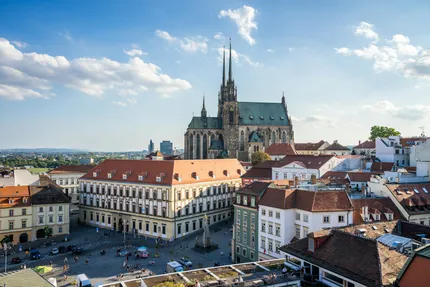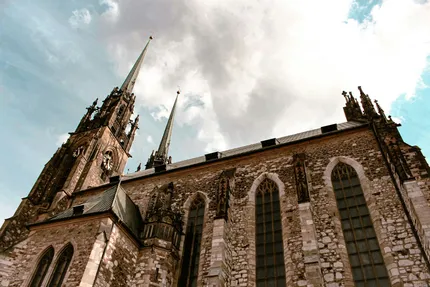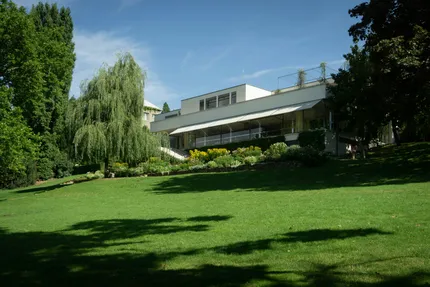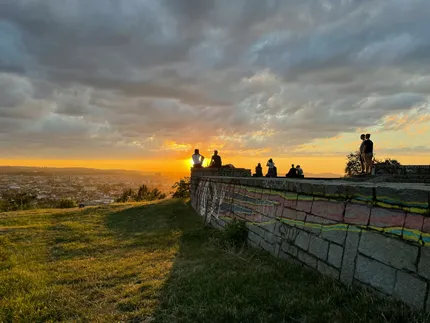CityTouring

City trip to Brno
Czech RepublicBrno, Czech Republic’s second city and the capital of Moravia, blends a medieval core, Habsburg-era streets, and standout modernism. Dominating Petrov hill, the Cathedral of Sts. Peter and Paul anchors a compact center of cafés, wine bars, and student energy. A short walk away, Špilberk Castle covers fortress and prison history, with hilltop views. Architecture fans come for Ludwig Mies van der Rohe’s Villa Tugendhat (UNESCO), an icon of functionalism; tickets require advance booking. Below ground, you can tour the Labyrinth under the Vegetable Market, the city’s historic water reservoirs on Žlutý kopec, and the haunting Ossuary at St. James—Europe’s second largest—or step into the 10-Z bunker under Špilberk.
Brno’s museums are strong: the Moravian Gallery, Technical Museum, and the Anthropos Pavilion with a life-size mammoth. Trams are frequent and cheap, so reaching Lužánky Park, the Brno Lake area, or Veveří Castle is easy. Evenings mean Moravian cuisine, craft beer, and local wines poured in cozy cellars. Compared with Prague, Brno is calmer, prices are lower, and you can cover highlights on foot over two days, with time left for a day trip.

Cathedral of St. Peter and Paul (Petrov)
Dominating Petrov Hill, the cathedral’s twin neo‑Gothic towers frame Brno’s skyline. Inside, Baroque chapels, stained glass, and an ornate organ reward a quiet visit. Climb to viewpoints for city panoramas, and note the local tradition: the “noon” bells ring at 11 a.m. Guided tours reveal earlier Romanesque foundations and wartime legends.

Villa Tugendhat
UNESCO‑listed modernist masterpiece by Ludwig Mies van der Rohe in Černá Pole. Guided tours showcase radical open‑plan living, the onyx wall glowing at sunset, original furnishings, and pioneering technology including retractable glass. Book well in advance; capacity is limited. The surrounding garden offers tranquil views over Brno and contextualizes the villa’s architectural significance.
Špilberk Castle
Medieval fortress turned Baroque prison overlooking Brno. Explore casemates once holding political prisoners, climb ramparts for panoramic views, and visit Brno City Museum’s exhibitions on the city’s history and architecture. Seasonal events and guided tours illuminate military defenses and everyday life. Accessible hilltop park offers walking paths, viewpoints, and picnic spots near the historic center.
Brno suits travelers who like compact, walkable cities with layered history and modern design. Architecture enthusiasts can spend a focused weekend on functionalism: Villa Tugendhat is the headline (reserve ahead), and Bohuslav Fuchs’s works, including Hotel Avion and other functionalist landmarks, show the city’s 20th‑century ambitions. History‑minded visitors will value Špilberk’s casemates, the Cathedral on Petrov, the Old Town Hall, and atmospheric underground tours plus the St. James Ossuary. Performing‑arts fans have options, from opera and ballet at the Janáček Theatre to the Mahen Theatre’s repertoire. If you travel with kids, VIDA! Science Center, the Brno Zoo, and seasonal boat rides on the Brno Lake make easy half‑day outings; gentle trails lead to Veveří Castle. Food and drink travelers will do well: South Moravian wines poured in bars around Jakubské náměstí, small breweries beyond the Starobrno brand, and straightforward Moravian dishes in hospody.
Students and budget travelers benefit from good‑value lodging, low‑cost trams, and a nightlife clustered along Česká and streets. For an active add‑on, the Moravian Karst is reachable by public transport for cave tours, including Punkevní Cave and the Macocha Abyss; book time slots in advance. Brno is less suited to those seeking blockbuster landmarks or luxury shopping, but for a two‑ or three‑night break centered on architecture, local culture, and easy day trips, it fits well. You can see the core sights without rush, eat and drink well, and leave with a clear sense of Moravia.
Three top reasons for a city trip to Brno
- Explore Brno’s rich architecture: UNESCO-listed Villa Tugendhat, imposing Špilberk Castle, soaring Cathedral of St. Peter and Paul, and Old Town Hall. Functionalist gems, medieval lanes, and panoramic city views abound.
- Dive into Brno’s distinctive vibe: labyrinth under Zelný trh, eerie Ossuary at St. James, Astronomical Clock, lively Jakubské náměstí bars, and Moravian wine, coffee, and craft beer culture across neighborhoods.
- Experience Brno’s creative energy: Mendel Museum at the Augustinian Abbey, Janáček Theatre and Brno Philharmonic, vibrant design scene, and citywide festivals like Ignis Brunensis, cafés, and street art in courtyards.

Best time to visit Brno
Late spring and early autumn suit Brno best. May and June bring mild days, long evenings, and outdoor seating across the center; parks are green, and day trips to the Moravian Karst are comfortable. The city’s Ignis Brunensis fireworks festival usually lights up the sky in late May or June, and August hosts the Špilberk International Music Festival. September to early October stays pleasant for sightseeing and wine bars, with harvest season in nearby South Moravia reflected on menus. July can be hot and some venues take holidays; December is atmospheric for Christmas markets, but expect freezing temperatures and short daylight.
More activities and things to see in Brno:
Ossuary at St. James Church
Europe’s second‑largest ossuary, beneath St. James Church near Jakubské náměstí, contains remains of tens of thousands, victims of wars and epidemics. Atmospheric lighting and interpretive panels explain burial practices and city history. The route is compact but impactful; expect cool temperatures and low ceilings. Tickets are timed, and photography rules are enforced respectfully.
Labyrinth under the Vegetable Market (Zelný trh)
Historic cellars beneath Zelný trh reveal Brno’s underworld of food storage, wine and beer production, and refuge during sieges. Guided tours lead through interconnected chambers with period artifacts, alchemical curiosities, and clear explanations of daily life. The route includes uneven steps and low passages. Combine your visit with the lively open‑air market above.
Capuchin Crypt
At Kapucínské náměstí, the Capuchin Crypt presents naturally mummified monks and notable townspeople from the 17th–18th centuries. Informative panels explain ventilation and burial customs behind the preservation. The exhibition is small yet memorable; maintain a respectful tone. Combine with nearby Zelný trh and the Labyrinth. Occasional closures occur for services, so check hours in advance.
Moravian Gallery in Brno
One of the Czech Republic’s leading art institutions, the Moravian Gallery spans several venues: the Governor’s Palace, Pražák Palace, and the Museum of Applied Arts. Collections cover painting, sculpture, design, and graphic arts, with strong modernism and functionalism holdings. Rotating exhibitions, archives, and the International Biennial of Graphic Design make return visits rewarding. Combined tickets available.
Mendel Museum and Augustinian Abbey
At the Augustinian Abbey in Old Brno, the Mendel Museum explores Gregor Mendel’s groundbreaking genetics experiments. Exhibits detail his methods, pea varieties, statistics, and correspondence, with a reconstructed greenhouse and seasonal plantings outside. The complex includes a peaceful cloister and church. Occasional lectures and workshops run in English; allow an hour to appreciate the material.
Brno Reservoir and Veveří Castle
Northwest of the center, the Brno Reservoir offers boating, swimming areas, lakeside paths, and forest trails. Seasonal ferries connect to Veveří Castle, a hilltop fortress with courtyards, exhibitions, and views over the water. Combine hiking or cycling with a castle visit. In summer, beach bars and family attractions operate; services scale back in winter.
Náměstí Svobody and the Astronomical Clock
Brno’s central square mixes historic facades with contemporary design and frequent events. The black granite “astronomical clock” releases a glass marble daily at 11 a.m., drawing crowds to try catching it. Cafés, tram connections, and nearby shopping streets make this an easy orientation point. Seasonal markets and concerts enliven evenings from spring through Christmas.
Getting around in Brno
Brno is easy to navigate without a car. The historic core and surrounding neighborhoods are compact and walkable, with many pedestrian streets. Public transport (trams, trolleybuses, and buses run by DPMB within the IDS JMK network) is extensive, frequent, and operates late at night with dedicated night lines. You can buy short-term tickets or day passes, and most vehicles have onboard validators that accept contactless bank cards; just tap when boarding. Low-floor trams and buses are common, and real-time info is shown at many stops and in journey-planning apps. Cycling is increasingly practical: there are marked lanes and riverside paths, though some routes have hills and traffic. Dockless bike-share and e-scooter services operate seasonally in central districts. Taxis and ride-hailing apps are widely available. If you’re driving, expect paid parking zones in the center and occasional congestion; using park-and-ride lots on the outskirts and continuing by tram is easier. Regional trains and buses provide quick links to suburbs, the Brno Exhibition Centre, and nearby towns.
Getting to Brno
The nearest airport is Brno–Tuřany (BRQ), about 8 km southeast of the center. It has limited international service (often to London and seasonal destinations). Bus E76/N89 connects the terminal to Brno hlavní nádraží in roughly 20 minutes, where all trains and long-distance coaches depart. For broader flight options, Vienna International Airport (VIE) is the most convenient hub, with global connections; reach Brno in 2-2.5 hours by frequent RegioJet coaches from the airport or by train from Wien Hbf via Břeclav. Prague Václav Havel Airport (PRG) also offers extensive long-haul links; take an airport bus to Praha hlavní nádraží and a direct ČD, RegioJet, or Leo Express train to Brno (about 2.5-3 hours). Bratislava Airport (BTS) is another nearby low-cost option, with direct buses to Brno. Brno lies on the Prague–Vienna/Bratislava mainline. There are direct international trains to Vienna, Bratislava, Budapest, and Prague several times daily. Long-distance buses by RegioJet and FlixBus connect Brno with Prague, Vienna (including VIE), Bratislava, Budapest, Kraków, Berlin, and other Central European cities.